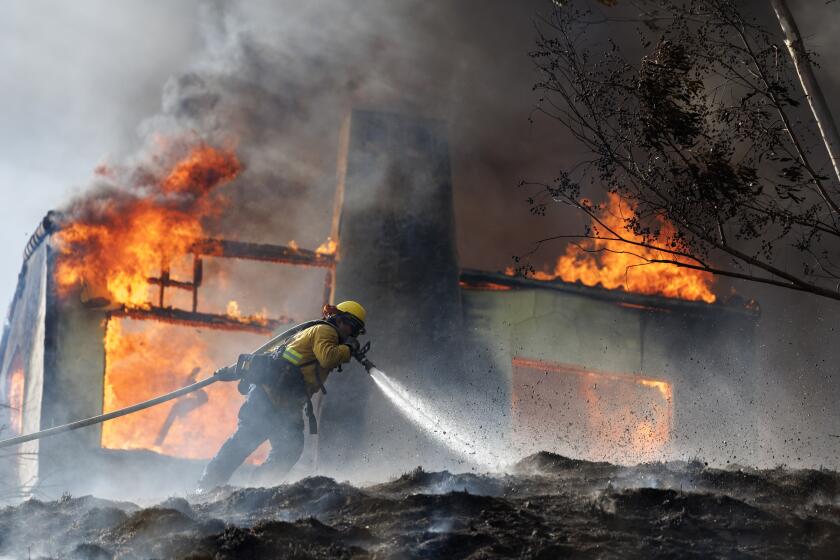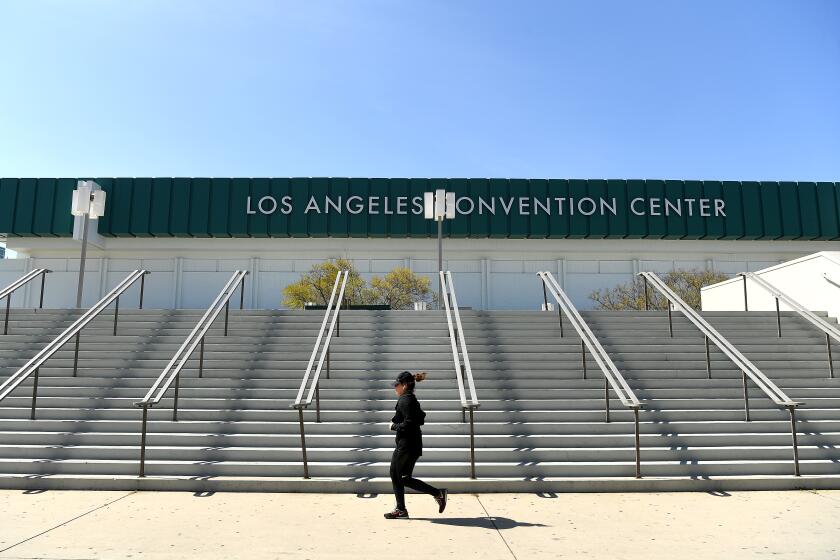
- Share via
- Only 21% of properties within the Eaton fire perimeter were in Cal Fire’s “very high” fire hazard severity zones.
- Yet 94% of those properties had “severe” or “extreme” wildfire risk, according to more advanced wildfire models.
- Cal Fire knew its model couldn’t account for extreme wind-driven fires like Eaton, but decided that more complex approaches were not developed enough to rely on.
The Tunnel fire broke out in a wooded canyon just minutes away from UC Berkeley, where David Sapsis was working on his PhD in fire science. Five years into a drought, on a torrid October morning in 1991, with the wind whipping at over 60 mph, Sapsis knew it spelled trouble.
An eyewitness watched as a single ember landed on a tree just outside the burn area, igniting it. Then, all hell broke loose. The fire killed 25 people and injured 150 more. It engulfed more than 3,800 structures throughout the hilly communities and raced toward Oakland.
But then, the winds died down. Sapsis — who would spend much of the aftermath studying the forensics of the fire — was left with a terrifying thought that has stuck with him ever since.
“That fire,” he said, “could have gone to Lake Merritt if the winds would have persisted.” Straight through Oakland.
Thirty-three years later, Sapsis, who now leads Cal Fire’s hazard mapping efforts, watched his nightmare play out in real time in Altadena. With exceptional winds that blew the fire deep into an urban center, and exceptional dryness that provided the fuel for the flames to keep growing, it was a scenario Cal Fire knew its fire models couldn’t handle.
“I do believe, when we start to complete some research synopsis of this fire event,” Sapsis said, “that we’re going to be looking at a recalibration for what urban conflagration distances can be. And the ramifications of that will be significant.”
While a newer experimental fire modeling approach used by the public-interest company First Street had identified Altadena as having significant fire risk and provided a detailed scale of risk levels prior to the disaster, Cal Fire’s maps only showed a ring of “very high” red hazard in the wildlands next to Altadena, with the vast majority of the city unmarked.
An analysis by The Times found that of the thousands of Altadena properties within the Eaton fire’s perimeter modeled by First Street, the company had identified 94% as having either “severe” or “extreme” fire risk, carrying at least a 1 in 7 chance of being in a wildfire over a 30-year window. By comparison, just 21% of those properties were in a Cal Fire “very high” fire hazard severity zone.
It’s the result of Cal Fire taking a more conservative approach — using a less precise, though more well-established modeling method with decades of science to back it instead of promising newer approaches that can better model nightmare scenarios.
And, despite the maps becoming Californians’ go-to source for hazard information, Cal Fire stresses its directive from lawmakers was to determine where officials need to enforce often costly fire building codes and other fire safety measures — not to provide the public with a nuanced understanding of their fire risk.
“Our view of this is, do our maps reflect these cutoff points [for] which the regulations apply,” Sapsis said. “In contrast, First Street’s is a much more broad assessment of potential damage to the public, really designed for public awareness.”
Independent modelers found thousands more Altadena properties had dangerously high chances of experiencing a wildfire
First Street, a public-interest climate risk assessment company, created a model to assess the probability of properties being in a wildfire. It found a significant potential for extreme winds to push fire deep into Altadena.
First Street “fire factor”
Minor
Moderate
Major
Severe
Extreme

Cal Fire’s “very high” fire
hazard severity zone
Altadena Dr.
Altadena
Lake Ave.
Eaton fire
perimeter
1 MILE

Cal Fire’s “very high” fire
hazard severity zone
Altadena Dr.
Altadena
Lake Ave.
Eaton fire
perimeter
1 MILE
First Street, California Department of Forestry and Fire Protection, National Interagency Fire Center
Sean Greene LOS ANGELES TIMES
Cal Fire’s maps follow a trail of disaster. The state first ordered the agency to create the maps in the aftermath of the 1980 Panorama fire in San Bernardino that killed four, with the goal of identifying areas with a heightened risk of wildfire. Eventually, the maps became integral in policymaking: A decade later, the Tunnel fire pushed lawmakers to require residents in “very high” fire hazard severity zones to follow defensible space and home hardening measures.
After San Diego County’s Cedar fire in 2003, California began requiring homes in “very high” fire hazard severity zones to comply with new wildfire building codes, including using ignition-resistant materials; covering vents that could allow embers to enter homes and cause ignition from the inside out; and installing multi-pane or fire-resistant windows.
Today, the severity zones are referenced in at least 50 different pieces of legislation, codes, grants and other state rules and documents.
In 2021, the state passed a law requiring local jurisdictions to consider the fire hazards for long-term community land-use planning, not just individual structures, in “very high” fire hazard severity zones. For example, local governments have to consider evacuation routes and peak load water-supply requirements for disasters, and they must locate essential public facilities such as hospitals and emergency command centers outside high fire-risk areas “when feasible.”
Scientific studies have found home hardening measures are effective at reducing the chance of a home burning to the ground but are not a silver bullet. One study looking at wildfires in Southern California found homes with multi-pane windows and concrete roofs were 26% and 18% less likely to burn, respectively.
Experts still disagree over whether homes can be completely fireproofed in a wind-driven ember fire.
On the lands for which Cal Fire is responsible, the state agency maps “moderate,” “high” and “very high” severity. But for parts of California where local firefighters are in charge of coordinating a response, Cal Fire has published only the “very high” zones.
The agency had planned to release “moderate” and “high” zones in January, more than two years after the state Legislature requested them, but the Los Angeles wildfires delayed the release.
Creating the maps is an arduous process that requires scrutinizing detailed data across the state — down to small pockets of potentially flammable wildlands within cities — and coordinating with the hundreds of cities and counties that the maps will directly affect, according to Cal Fire.
While it’s difficult to say how the hazard zone requirements would’ve changed the outcome in Altadena, fire safety experts and advocates say they can go a long way toward keeping communities safe. However, having such requirements doesn’t mean homeowners will actually implement them, and enforcement is often spotty, safety advocates say.
Cal Fire’s mapping has followed the standard practices in the field of wildfire modeling: They looked at risk factors for fire across the wildlands — vegetation type, terrain and weather conditions — and laid them out on a digital map. They then used equations to predict the fire frequency and intensity across the map to come up with hazard severity levels.
To calculate the hazard within developed areas like Altadena, Cal Fire looked at the hazard in the nearby wildlands and estimated how far a potential fire and its embers could push into the city from there.
But the Cal Fire model is static — a snapshot. It has no way of simulating how fire actually progresses, especially deep into urban centers. It means the model could not simulate how a wildland fire could decimate a community like Altadena.
“Fires spread across space over time. That’s the reality of how things happen,” Sapsis said. “Let’s say I’m trying to assign hazard on the west side of Lake Tahoe. If I don’t actually have a mechanism of spread influencing hazard, I’m kind of missing the fact that fire can’t come from the east.”
The Eaton fire was the type of extreme outlier for which this static approach cannot account. The blisteringly fast winds persisted for hours, pushing the fire significantly farther into developed areas than fire scientists normally expect.
But it wasn’t unprecedented.
Senate Bill 610 seeks to repeal current rules that classify state and local lands into ‘moderate,’ ‘high’ and ‘very high’ fire hazard severity zones.
In an analysis before the Eaton fire occurred, Sapsis found that about 95% of home loss from past fires occurred in zones that Cal Fire had deemed as “very high” fire hazard. Most of the remaining 5% was due to one event: the 2017 Tubbs fire in Santa Rosa. As with Eaton, extreme strong and persistent winds had driven the fire right through the city, killing 22 and destroying more than over 5,600 structures.
An analysis by The Times found that 83% of the more than 9,400 structures destroyed in the Eaton fire were outside Cal Fire’s “very high” fire hazard severity zones, while only 0.1% of structures destroyed in the Palisades fire were outside the “very high” zones — just two nonresidential buildings.
Fewer than 1 in 5 buildings destroyed in the Eaton fire were located in fire-prone areas
About 17% of razed structures — most of which were in Altadena — stood within zones designated as “very high” fire hazard.
Extent of damage
Destroyed
Damaged/affected
No damage

Detailed
2 MILES

Very high fire hazard
Loma Alta Dr.
Lake Ave.
Altadena Dr.
Altadena
Eaton fire
perimeter
0.5 MILE

Very high fire hazard severity
Loma Alta Dr.
Lake Ave.
Altadena Dr.
Altadena
Eaton fire
perimeter
0.5 MILE
Minor structures are not mapped. Shaded green areas are federal parklands not analyzed by Cal Fire.
California Department of Forestry and Fire Protection, National Interagency Fire Center
Sean Greene LOS ANGELES TIMES
The Palisades fire burned in an area deemed “very high” hazard

Calabasas
Very high fire hazard
Palisades fire
perimeter
Pacific
Palisades
Sunset Blvd.
Malibu
Santa
Monica
Pacific Ocean
2 MILES

Calabasas
Very high fire hazard
Palisades fire
perimeter
Sunset Blvd.
Pacific
Palisades
Pacific Ocean
Santa
Monica
2 MILES
Shaded green areas are federal parklands not analyzed by Cal Fire.
California Department of Forestry and Fire Protection, National Interagency Fire Center
Sean Greene LOS ANGELES TIMES
“Both Altadena and Tubbs are fundamentally exposing a weakness of our operational spread models in urban landscapes because they haven’t figured out the vexing problem of structural fuel contribution to spread,” Sapsis said.
Cal Fire was aware of the weakness after Tubbs, but found that the field hadn’t yet developed sufficient modeling solutions to address it.
One small company, looking at data from across the country, was working on an answer. First Street would go on to become a national leader in publically available disaster risk assessment and develop a fire model that placed Altadena squarely in a “severe” fire risk zone — its second highest ranking.
To start, the company used similar inputs as Cal Fire: vegetation, terrain and weather conditions — but First Street’s model also considered houses as fuel sources. Wooden homes and brushy lawns are likely to fuel a fire, while concrete homes and roads can help stop it.
First Street also gave their digitized world rules of physics: how flames grow and move across terrain and the wind dynamics that can blow embers miles away. Then, they ignited virtual fires and watched what happened. Millions of them. To First Street, it became clear that with intense persistent winds, some homes could fuel a fire deep into a city, creating a multibillion-dollar disaster.
“Because those houses are burnable, then the physics model allows the houses themselves to spread the fire from one to the other,” said Jeremy Porter, head of climate implications at First Street. “I think that, in particular, is why you see our models show the Altadena fire and the Palisades fire moving further into the neighborhood than what a lot of the other wildfire models are showing.”
First Street’s approach has gained popularity among fire modelers in the last decade. Sapsis says he hopes to use it for future Cal Fire hazard maps. The agency has still yet to release “moderate” and “high” designations for locally managed fire-risk zones based on its old models; however, it’s likely to be even longer yet until any new modeling techniques are incorporated.
Regardless, fire modelers emphasize that all fire hazard maps are ultimately based on probability. Just because a fire model says fire is unlikely at a certain location doesn’t mean it’s impossible.
“Probability is like gambling,” Sapsis said. “It doesn’t mean — when you spin the wheel and you said it’s a 70% chance of it being a 10 or above — that it can’t land on three.”
It means, for those who spend their lives studying the probability of worst-case scenarios, the space between 0% and 100% is where communities have to live.
“This is a tough pill to swallow,” Sapsis said, “but there is non-zero level risk out there in vast portions of the landscape that fires could get to under the most extreme conditions.”
Sapsis sees Altadena as a learning experience. He’s hopeful California will eventually catch up and heed the fires’ lessons.
“If you just look at the house loss statistics in California, something’s happening. The numbers are just suddenly orders of magnitude higher than they were on average per year, and so we’re really trying to catch up,” he said. “I think the existing framing of our safety regulations for new construction is generally bearing fruit, but there’s more work to be done.”











